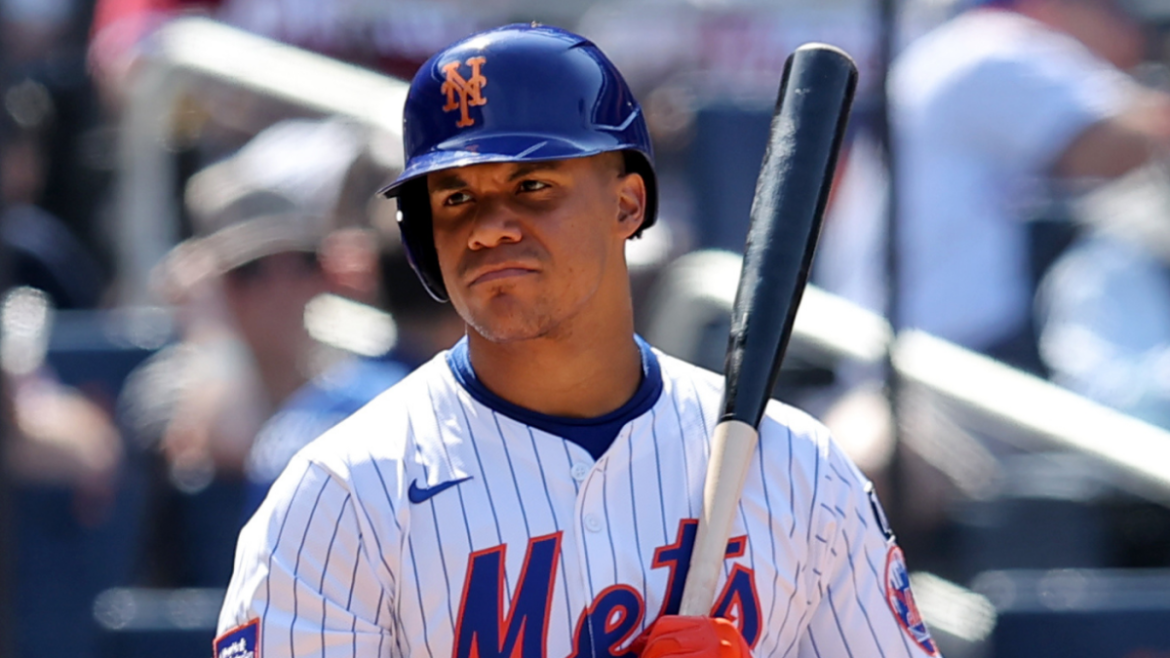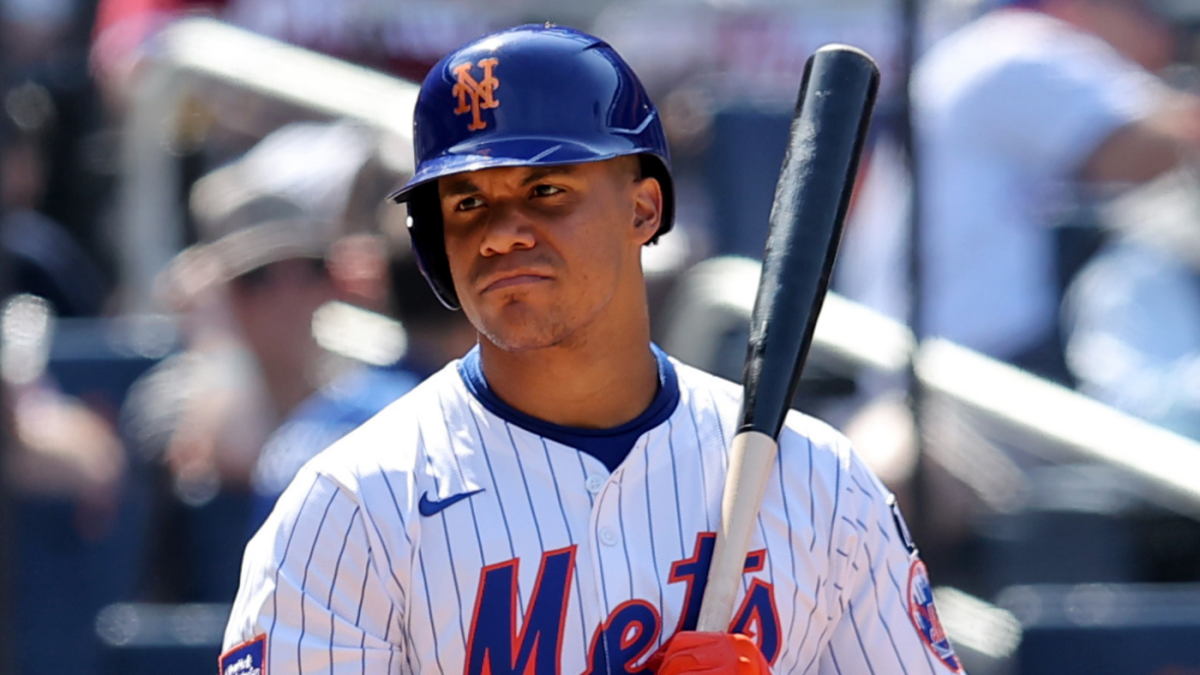Juan Soto’s Struggles with the Mets: An In-Depth Exploration of the $765 Million Star’s Early Season Red Flags
—
At the outset of the 2025 season, the New York Mets secured what has been described as the most monumental free-agent signing in professional sports history—a 15-year, $765 million contract with outfielder Juan Soto. This investment represented not only financial commitment but heightened expectations for Soto to single-handedly elevate the Mets’ performance and redefine baseball’s power dynamics in New York. Yet, fewer than 50 games into the new era, troubling signs have emerged from Soto’s performance, eliciting concern from analysts, executives, fans, and media alike. By peeling back the layers of his early-season struggles, a multifaceted picture arises that helps explain why the player known for his prodigious skills might currently be “un-Soto.”
Three Critical Warning Signs Behind Juan Soto’s Underwhelming Start
One of the most telling red flags comes from Statcast data revealing a troubling drop in Soto’s bat speed—a key biometric closely tied to offensive effectiveness. His bat speed has declined by 2 mph relative to the previous season, marking the third-largest year-to-year drop in MLB and placing him among a concerning cohort of Mets players experiencing similar downturns. Since bat speed directly correlates to power generation and contact quality, this dip hints at either underlying physical fatigue, mechanical changes, or other undisclosed factors compromising his ability at the plate.
Parallel to this biomechanical issue are notable slumps in situational hitting. Soto has struggled significantly with runners in scoring position, going 1-for-20 in these critical moments during recent series. This slump has compounded to lower his batting average and on-base production, frustrating expectations given his historic consistency in clutch hitting. His inability to reach base safely in his final six plate appearances against rivals like the Yankees hints at a confidence or approach issue rather than mere bad luck.
Another conspicuous red flag stems from Soto’s perceived hustle and engagement on the field. Multiple media reports and team sources have scrutinized Soto for not fully hustling on plays, such as easing out of the batter’s box or slower baserunning, leading to growing fan frustration. Though Soto has denied accusations of “lollygagging,” the subjective perception has become a narrative that threatens to overshadow his on-field contributions and raise questions about his attitude and integration within the Mets clubhouse culture.
The Weight of a $765 Million Contract: Expectations vs. Reality
The gargantuan size and length of Soto’s contract have placed an unprecedented spotlight on him. As the highest-paid player in MLB history, every plate appearance is scrutinized to assess whether the Mets are receiving proportional value. The pressure to justify this contract can be immense, balancing personal performance, media scrutiny, fan expectations, and the broader implications for the franchise’s future.
Compounding these pressures is the symbolic significance of his signing within the narrative of New York baseball. Soto’s decision to spurn the Yankees’ 16-year, $760 million offer in favor of the Mets cuckolded a traditional rivalry and injected heightened drama into his tenure. His first series back in Yankee Stadium was marked by boos and a disappointing 1-for-10 showing. This personal rivalry dynamic, married with immense financial investment, has seemingly amplified external and internal pressures that may contribute to performance anxiety or distractions.
Mets Management and Executive Concerns
Mets executives, while having committed heavily to Soto, have reportedly begun voicing concerns over his recent “miserable” performances and signs of disengagement. The team has publicly indicated plans to discuss hustle and attitude, signaling an organizational effort to recalibrate his approach and reestablish alignment with team standards.
Manager Carlos Mendoza has addressed the issue directly, clarifying that conversations with Soto regarding effort are underway but maintaining a tone of support. The internal challenge rests on balancing respect for Soto’s superstar status while fostering a culture of accountability that ensures his presence translates into tangible team success.
The Larger Context: Team Performance and Future Outlook
Despite the turbulent start, Soto’s presence has been a significant factor in the Mets’ positioning atop the NL East, illustrating that his impact extends beyond personal statistics. His reputation as a calm, ferocious competitor with prodigious skill underpins the team’s long-term hopes that he will regain his groove and fulfill the enormous promise envisioned when the contract was signed.
Moreover, the Mets’ ownership and front office have framed Soto’s acquisition as a long-term civic and philanthropic investment in New York baseball, suggesting patience as Soto adapts and evolves. Notable voices in the sport suggest that while early struggles generate headlines, the holistic evaluation must consider the trajectory over several seasons given the unprecedented contract duration.
Conclusion: A Storied Start Marked by Challenges but Not Defeat
Juan Soto’s rocky beginning with the New York Mets underscores the complexity of transitioning a superstar under immense financial and psychological weight. Declining bat speed, situational slumps, and questions around hustle converge as early warning signs that his adaptation is incomplete. Yet, these issues exist against a backdrop of unprecedented contract size, high expectations, and intense rivalry-driven pressure.
The Mets face the dual challenge of supporting Soto’s potential resurgence while demanding consistent effort and improvement reflective of their historic investment. How Soto responds to these early tests may define not only his legacy with the Mets but the contours of baseball’s evolving relationship with megastar contracts.
For fans and analysts alike, the unfolding story of Juan Soto in New York offers a compelling lens on the pressures inherent in modern professional sports, where talent, money, and expectation collide. The $765 million man may be off to a slower start than hoped, but his capacity for recalibration and rebound remains the key narrative to watch in the seasons ahead.





